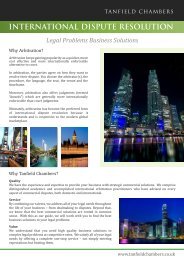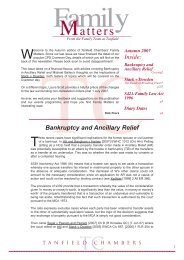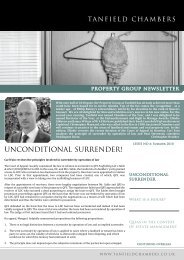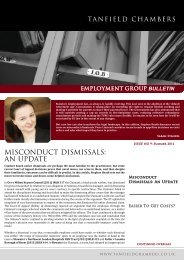Link to newsletter - Tanfield Chambers
Link to newsletter - Tanfield Chambers
Link to newsletter - Tanfield Chambers
Create successful ePaper yourself
Turn your PDF publications into a flip-book with our unique Google optimized e-Paper software.
Sarah Stanzel<br />
Called in 1999, Sarah practises exclusively<br />
in employment law and regularly appears<br />
before the ET and EAT in a range of matters<br />
for both Claimants and Respondents. She<br />
has also appeared in the Court of Appeal<br />
including acting as junior counsel for the<br />
claimant in GAB Robins v Triggs [2008]<br />
IRLR 317. She increasingly receives instructions in cases with a<br />
cross-border or international element. Her languages include<br />
German, French, Italian, Spanish and Portuguese and she regularly<br />
advises clients both in the UK and abroad in their respective<br />
language, having undertaken work placements in law firms in<br />
Frankfurt, Paris, Rome, Madrid and Lisbon. She has recently<br />
travelled abroad <strong>to</strong> lecture before the Italian and Spanish<br />
Employment Lawyers Associations and at the Annual Conference of<br />
the European Employment Lawyers Association.<br />
RECENT MITIGATION DECISIONS<br />
In Islam Channel Ltd v Ridley [2009] All ER (D) 89 (Aug), the<br />
claimant obtained a freelance job at first better paid than her previous<br />
job but by the hearing it was less well paid, <strong>to</strong>tal earnings from<br />
dismissal <strong>to</strong> hearing being better than in the old job. The EAT held that<br />
past earnings should not be set off against future loss due <strong>to</strong> the<br />
insecure nature of freelance work. In Aegon UK Corp Services Ltd v<br />
Roberts [2009] IRLR 1042, the Court of Appeal held that for the<br />
purpose of assessing the level of remuneration (in old and new job),<br />
pension is part of the remuneration package. In Stuart Peters Ltd v<br />
Bell [2009] IRLR 941, the EAT held that the Nor<strong>to</strong>n Tool principle<br />
applies so that in both direct and constructive dismissal cases, missing<br />
notice pay must be awarded in full whether or not the claimant had<br />
alternative earnings during the notice period.<br />
our authors<br />
TC<br />
WHERE ARE WE WITH EM<br />
Employment status could not be more complicated. A claimant m<br />
dismissal claim, a differently defined “employee” or “contract w<br />
working time claim under the Working Time Regulations, and a<br />
disclosure claim. Laura Robinson and Gemma de Cordova provid<br />
the implications.<br />
This article considers the practical implications where status is disputed,<br />
then the areas visited most often by the case law: attempts <strong>to</strong> avoid<br />
employment status through sham agreements, agency worker cases and<br />
contract worker status under the anti-discrimination legislation.<br />
PRELIMINARY HEARINGS ON STATUS?<br />
DISCRIMINATION<br />
Pecuniary loss in discrimination cases is based on putting the claimant<br />
in<strong>to</strong> the position he would have been in had the act of discrimination<br />
not occurred. In Chagger v Abbey National plc and another [2010]<br />
IRLR 47, the Court of Appeal confirmed that this meant the ET had <strong>to</strong><br />
assess the likelihood that the claimant would have been dismissed in<br />
any event. That meant making a reduction proportionate <strong>to</strong> the chance<br />
that the claimant would have been dismissed if redundancy had not<br />
been discrimina<strong>to</strong>ry (like a Polkey reduction). However, somewhat<br />
surprisingly, the Court held that future loss was not necessarily limited<br />
<strong>to</strong> the period during which the claimant would have remained<br />
employed had he not been the subject of unlawful discrimination. This<br />
is because if he had left the employment voluntarily, he would not have<br />
chosen a position with no income and no stable platform from which <strong>to</strong><br />
find other work. The Court of Appeal also stated that where employees<br />
suffer a stigma on the labour market as a result of having brought a<br />
discrimination complaint, this can be taken in<strong>to</strong> account when<br />
assessing how long it will take them <strong>to</strong> find another job.<br />
As far as injury <strong>to</strong> feelings is concerned, the Ven<strong>to</strong> scale was recently<br />
updated in line with inflation in Da’Bell v NSPCC [2010] IRLR 19, EAT.<br />
The lowest band of awards now runs up <strong>to</strong> £6,000, the middle band<br />
from £6,000 <strong>to</strong> £18,000 and the highest band from £18,000 <strong>to</strong> £30,000.<br />
Meanwhile, in Taylor v XLN Telecom Ltd [2010] IRLR 499, the EAT<br />
overturned the ET’s decision not <strong>to</strong> award compensation in a<br />
victimisation claim because the claimant was unaware of any<br />
discrimina<strong>to</strong>ry intent. They said that both injury <strong>to</strong> health and injury <strong>to</strong><br />
feelings should be compensated as they flowed from the employer’s<br />
actions, even if the claimant did not know the act was discrimina<strong>to</strong>ry.<br />
SARAH STANZEL<br />
A useful starting point is the very recent guidance on preliminary<br />
hearings in Leeds City Council v Woodhouse & Another [2010] EWCA<br />
Civ 40, where the Court of Appeal were considering whether the claimant<br />
was a contract worker within section 7 RRA 1 following a PHR on that<br />
issue in the tribunal. They observed that such a preliminary hearing<br />
involved the tribunal making extensive findings of fact. Two concerns<br />
were raised. Firstly, the scope of the evidence potentially relevant <strong>to</strong> the<br />
section 7 issue may not be immediately obvious because the tribunal has<br />
<strong>to</strong> examine the terms of the contract and how the contract operated in<br />
practice. It would therefore be preferable for the issue <strong>to</strong> be heard as part<br />
of the entire case. Secondly, as the section 7 issue is largely one of fact it<br />
should be determined by a full tribunal and not a judge alone.<br />
Arguably the concerns raised by the Court of Appeal apply <strong>to</strong> all cases<br />
where employment status is in issue. Extensive evidence must be heard in<br />
‘sham’ cases, ‘agency worker’ cases, and ‘contract worker’ cases under the<br />
discrimination legislation, <strong>to</strong> determine the true relationship between the<br />
parties.<br />
“... if strict construction is applied “armies of lawyers will simply<br />
place substitution clauses, or clauses denying any obligation <strong>to</strong><br />
accept or provide work in employment contracts, as a matter of<br />
form, even where such terms do not begin <strong>to</strong> reflect the real<br />
relationship”“<br />
The danger of a Tribunal being <strong>to</strong>o quick <strong>to</strong> determine the strength of an<br />
agency worker’s claim had already been identified by the EAT in Evans v<br />
Parasol Ltd & Ors. (Bean J) 23/7/2009. In light of the complexity of the<br />
law relating <strong>to</strong> agency workers and the limited documentation available<br />
pre-disclosure, Bean J considered that it would be a bold employment<br />
judge who would strike out a claim on the basis of status at an early stage.<br />
“<br />
i<br />
t<br />
t<br />
1Race Relations Act 1976<br />
2Snook v London and West Riding Investments Limited<br />
W W W. TA N F I E L D C H A M B E R S . C O . U K






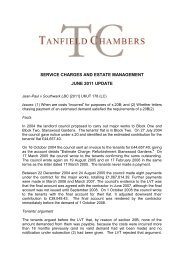
![Re Clarise Properties Ltd [2012] UKUT 4 (LC) - Tanfield Chambers](https://img.yumpu.com/36301708/1/190x245/re-clarise-properties-ltd-2012-ukut-4-lc-tanfield-chambers.jpg?quality=85)


